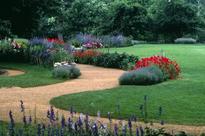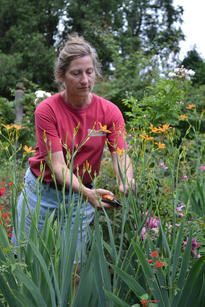Bring Your Garden Indoors: Plant an Heirloom Cutting Garden!
Thomas Jefferson, planter of 330 different vegetable varieties and celebrated today as “America’s first foodie,” was also passionate about growing ornamental flowering plants, both native and exotic, in the gardens at Monticello. Writing to his granddaughter, Ann Cary Randolph, from Washington in 1807, President Jefferson explained,
I find that the limited number of our flower beds will too much restrain the variety of flowers in which we might wish to indulge...& therefore I have resumed an idea...of a winding walk surrounding the lawn before the house, with a narrow bed of flowers on each side. This would give us abundant room for a great variety.
On the back of this letter, Jefferson sketched his idea for flower beds lining a winding walk around the flat, grassy lawn just outside the house. This document, along with entries in Jefferson’s Garden Book and numerous letters with plant-loving peers, has greatly assisted in the restoration of the flower gardens at Monticello.
 Jefferson's plan for a winding walk at Monticello, June 7, 1807. Jefferson Papers, Massachusetts Historical Society
Jefferson's plan for a winding walk at Monticello, June 7, 1807. Jefferson Papers, Massachusetts Historical Society A section of the restored winding walk at Monticello today
A section of the restored winding walk at Monticello today
We grow a wide array of flowers perfect for cutting at the Thomas Jefferson Center for Historic Plants at Monticello, including many of the same lovely varieties selected by Jefferson for his own gardens. To supplement the selection of perennial flowers bursting from our borders, this year we decided to plant a small cutting garden of heirloom annuals in the same bed where we experimented with incorporating ornamental vegetables last year.
 Cutting the perennial Blackberry Lily
Cutting the perennial Blackberry Lily For this new annual planting, we focused on sun-loving heirlooms that are at their best from mid-summer into fall. The backbone of our cutting garden is a combination of Celosias and Amaranths, which are prized for their unusual flower heads that bloom for months on end, and their ability to dry well for long-lasting color indoors; we especially love curious Cockscomb (Celosia cristata), eye-catching Pink-Spiked Celosia (Celosia cristata var. spicata), and peculiar Love-lies-bleeding (Amaranthus caudatus). Two additional annuals that provide non-stop color and dry easily are the lofty Strawflower (Helichrysum bracteatum), known for its unique, everlasting flowers of pink, orange, yellow, and white, and the charming Globe Amaranth (Gomphrena globosa), great for lending shades of pink and purple to the front of a bed. The advantage of Globe Amaranth as a dried flower was recognized in the 18th century, when Englishman Peter Collinson advised Virginian John Custis: “If the flowers are gather’d in perfection and hung up with their Heads Downwards in a Dry shady Room, they will keep thear colours for years and will make a pleasant Ornament to Adorn the Windows of your parlor or study all the Winter.” Mr. Collinson’s succinct directions for properly drying such flowers should still be followed today.
We also rely on the popular Zinnia elegans, first brought into cultivation from South America in 1796; the cultivar mix ‘Benary’s Giant,’ from Ernst Benary’s seed house founded in Germany in 1843, produces a profusion of colorful, long-stemmed flowers that last for up to 10 days in a vase. The variety of wonderful old favorites for the late-season cutting garden is nearly endless, allowing one to try different combinations year after year. We also can’t do without Asters, Black-eyed Susan, Coneflowers, Dahlias, Marigolds, Yarrow, Sunflowers, Bee Balm, and much more!
Our resident flower arranger at CHP, Kathryn Nokes, uses her skills as a floral designer and horticulturist to create stunning arrangements for various events and special occasions at Monticello nearly year-round. In addition to the annuals and perennials mentioned above, Kathryn also depends on the beauty and structure provided by the branches of trees and shrubs such as Flowering Quince in late winter, Mock Orange in spring, Hydrangeas in summer, and American Beautyberry in fall. Learn the art of flower arranging from Kathryn at one of her popular workshops, and for further inspiration, tour CHP’s display gardens during one of our Open Houses (for dates and details, check the ‘In the Garden at Monticello’ schedule or sign up for email updates on www.monticello.org).
Whether you have a blank slate to embellish like Jefferson, or just a few spaces to tuck in a new plant here or there, why not try to increase the variety of flowering plants in your own garden with those also suitable for cutting and displaying indoors? Such double-duty flowers beautify both your garden and your home, and often provide nectar for hungry pollinators as well. Plants and seeds of many flower varieties that encourage you to bring your garden indoors can be found at www.monticelloshop.org.


